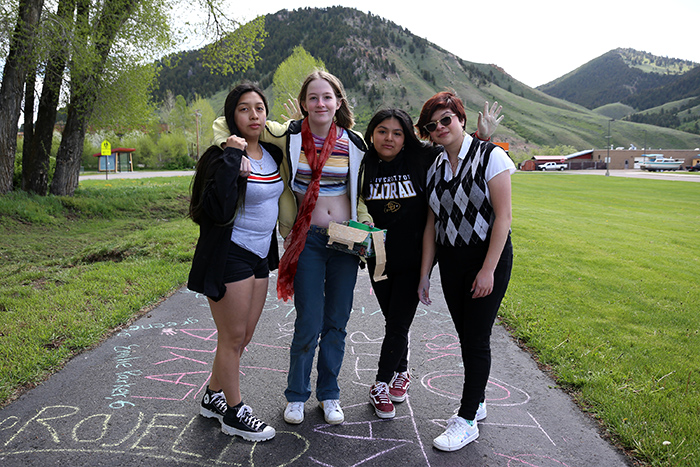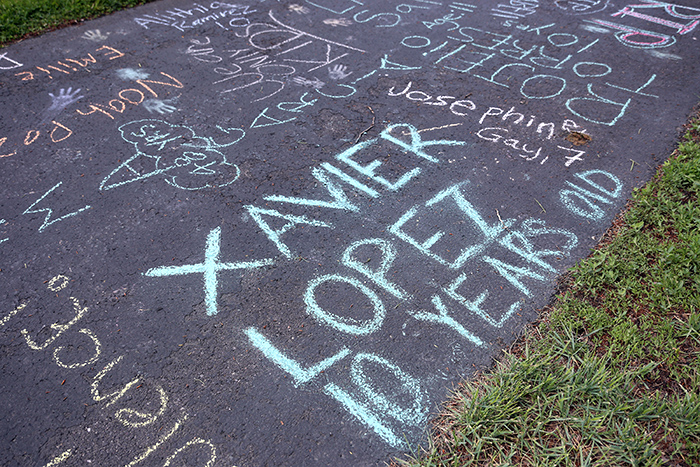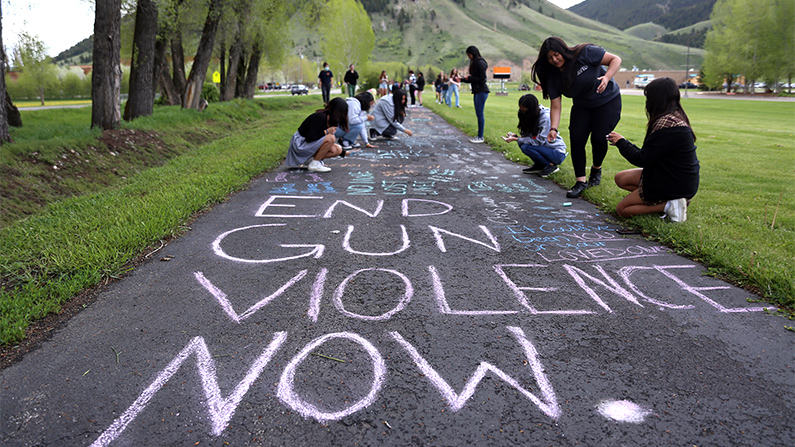After the May 24 school shooting in Uvalde, Texas, which left 19 students and two teachers dead, 17-year-old Jackson Hole High School student Acacia LaPrade looked around to see if she could find a local protest against gun violence to participate in. Nothing seemed to be scheduled, so she and 16-year-old Sophie Lamb organized their own.
Both students are wrapping up their junior year, and they were joined by a large crowd of their peers in a March For Our Lives-inspired school walkout at 10 a.m. on Monday, June 6.
Students walked out of Jackson Hole High School @TetonSchools at 10 a.m. this morning to protest gun violence. “This has to end,” one of the organizers told me.
A second community-wide protest is planned for 6 p.m. tonight at the Jackson Town Square. pic.twitter.com/ISeZzCWRlF
— Kyle S. Mackie (@kylemackieradio) June 6, 2022
“People are dying right now in the U.S., and I think we have a responsibility in this state to share our voice and say that we are scared,” said Lamb, making opening remarks to the crowd. “Wyoming has the third-highest rate of gun deaths in the country. We have the second-highest amount of gun ownership in the country, and we have the least restrictive gun laws in the country. I think we need to fight this and stand together and demonstrate that we dislike this.”
Fact-checking those statistics, Lamb’s spot on with the first two, according to the Centers for Disease Control and Prevention and the RAND Corporation’s Gun Policy in America initiative. As for the least restrictive gun laws, the Cowboy State consistently ranks among the country’s top five. And Wyoming students have lots of ideas about what to do to fight gun violence.

A group from the private Mountain Academy, which is part of Teton Science Schools, also joined Monday’s walkout. (Kyle S. Mackie/KHOL)
“I just think we need more regulations, more background checks,” said Elizabeth, 17. “I don’t think we need automatic rifles… people don’t really hunt with those, you know, they don’t really need to be accessible to buy.”
“We definitely might need more laws around it because it’s very scary when online nowadays you can buy a gun without needing any sort of license or registration for it,” said Oliver, 15.
“It’s easier to get a gun than it is to get a driver’s license, which is kind of concerning,” said Blanca, 17. “So, I think it’s going to take a lot of work from both sides to recognize that children from both sides are dying.”
Blanca added that she’s been really afraid of school shootings since she was in middle school, and when she talks about “both sides,” she means the longstanding partisan divide between Democrats and Republicans over gun policy. So, KHOL asked what her message to Congress would be if she had the opportunity to address lawmakers.
“Well, if they would listen, I would number one, say, ‘This is not about either side winning. This is not about who has more power in Congress. This is not about who could be president or should be president,’” she said. “This is about kids’ lives and peoples’ lives that are on the line. This is not just happening in schools—it’s happening in spas and stores and theaters. This is not about you.”
KHOL asked Wyoming’s all-Republican congressional delegation to respond to the students’ concerns. We also asked what they made of the bipartisan negotiations taking place over a package of gun safety measures. Rep. Liz Cheney didn’t respond to our request, but she voted no to a package of bills that would tighten gun restrictions and which passed the House Wednesday.
From @SenJohnBarrasso: “We all agree that we must find ways to curb violent crime and keep guns out of the hands of criminals. Legislation that takes away our constitutional rights guaranteed by the Second Amendment will not solve it. The focus should be on…
— Kyle S. Mackie (@kylemackieradio) June 8, 2022
Wyoming Senators John Barrasso and Cynthia Lummis provided statements that said restricting Second Amendment rights is not the answer to gun violence. Both leaders said they prefer to focus on securing schools and mental health. However, Sen. Lummis later told CNN she’s reconsidering supporting some gun control measures after getting a flood of calls from Wyomingites who want something to be done.
Back at the high school, the students walked a lap past the nearby Summit Innovations School and Jackson Hole Middle School, and then most went back to class. A smaller group stayed outside to write the names of victims of gun violence in chalk on the bike path in front of the school. Melany, 15, and Julieta, 16, used their phones to Google the names and ages of victims from Uvalde.

A group of Jackson Hole High School students, including Blanca, far left, Melany, second from right, and Julieta, far right, pose on the bike path where they wrote the names and ages of victims of gun violence. (Kyle S. Mackie/KHOL)
“So, the first one is Alexandria Aniyah Rubio, diez años. Alithia Ramirez, diez años,” the girls listed out loud, speaking in a combination of Spanish and English, clearly disturbed by the young ages.
“Dude, where were we when we were 10 years old?” Julieta asked her friend.
“We were just playing around,” Melany responded. “Yeah, I remember like playing with dolls and stuff,” Julieta added. “Imagine the parents [of the Uvalde victims], because a lot of them were Hispanic. My mom was always like, ‘Me muero si tu te mueres.’”
That’s a Spanish phrase that means, “If you die, I die.” Julieta also said her family recently agreed on a code to text each other in case of a mass shooting.
“My grandma was like, ‘This is a code for us. Like, this is our safety code,’” she said. “Type in this number to the group chat to tell us that you’re safe if anything happens.”

Xavier James Lopez was killed in the Uvalde shooting along with his best friend, Annabell Guadalupe Rodriguez. Both students were 10 years old. (Kyle S. Mackie/KHOL)
Many other students also seem to have accepted that there’s a risk they could encounter a school shooting at any time. Sophie, 15, joined the walkout with a group of friends from the private Mountain Academy, which is part of Teton Science Schools.
“I think a lot of people are desensitized to it because we kind of have to be, because we have to go to school,” she said. “We’re constantly afraid, but it’s something we still need to do. And so, I think growing up with this and always hearing it is—it’s so depressing and so sad.”
That emotional burden is part of why the Teton County School District said it has increased the number of counselors and social workers at its schools.
“We engage in a variety of efforts to support the mental health of students,” said the district’s Executive Director of Communications and District Services Charlotte Reynolds in a written statement. “As for the question about changing our policies after the tragedy in Texas, I would say no, we are not changing our policies but we do regularly review all of our protocols to ensure we are taking all measures possible to keep our students, employees and visitors safe while at school. We have numerous safety measures in place at each school to ensure our buildings are secure, provide annual training for staff [and] we work closely with law enforcement and emergency services.”

Student organizer Sophie Lamb makes closing remarks during the walkout at Jackson Hole High School on Monday, June 6. (Kyle S. Mackie/KHOL)
“We also review the circumstances of the horrible incidents like the one in Uvalde to understand what led to the incident and any lessons we can learn from such tragedies,” the statement continued.
The Wyoming Department of Education also announced this week that it will hold a series of roundtable discussions this summer with superintendents from across the state to talk about school safety. Every Wyoming superintendent will be required to attend at least one of the meetings, according to the department’s Communications Director Linda Finnerty.
“The heavy responsibility of school safety, you know, for students and for staff, does lie at the local level,” Finnerty said. “So, we want to make sure that we are hearing what their challenges are and that where we can support, we do.”






